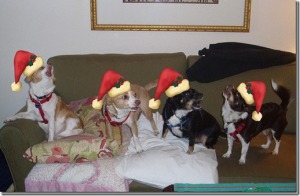Reverse Sneezing, Chihuahua Honks or Mechanosensitive Aspiration Reflex
Reverse sneezing: Mechanosensitive Aspiration Reflex or Paroxysmal Respiration isn’t a sneeze at all and isn’t an illness, but it is a condition that small dog owners should be aware of.
 If you have ever been startled by your dog or cat exhibiting snorting, honking and gasping noises you have probably experienced reverse sneezing. It makes you feel helpless while you watch your canine or feline friend appear to be struggling to breathe, but although alarming, especially to a first time pet owner, it appears and sounds much worse than it is.
If you have ever been startled by your dog or cat exhibiting snorting, honking and gasping noises you have probably experienced reverse sneezing. It makes you feel helpless while you watch your canine or feline friend appear to be struggling to breathe, but although alarming, especially to a first time pet owner, it appears and sounds much worse than it is.
There is no reason to panic. Reverse sneezing is not a serious condition andgenerally poses no threat to a dog or cat”s health or longevity. They are not having a seizure, and it also actually has nothing to do with sneezing, but is a spasm caused by an irritation of the soft palate. The soft palate is a soft, fleshy tissue extension off the hard palate, or roof of the mouth. Small dogs in particular can exhibit this behavior and certain breeds may be predisposed to it. It has sent many a distraught owner to the vet in panic.
Reverse Sneeze Videos:
Puggle Preston Reverse Sneezing
Some animals can have this condition for their entire lives, or it may develop as the dog ages. During the spasm, the pet will usually turn their elbows outward and extend their neck while gasping inwards with a distinctive snorting sound. Gently massaging the throat area or pinching their nostrils shut so they must breath through their mouth can help shorten the episode. Sometimes taking the pet outside in the fresh air stops the spasm. Once the attack ceases, all goes back to normal.
(Another technique sometimes used to stop a bout of canine reverse sneezing by behavior specialist Sarah Wilson is to try to get the dog to swallow, touching the back of the tongue if that is safe. Sounds like it would work with a cat as well.)
It is thought that the pharyngeal spasm can be caused by a number of irritants, including dust and pollen, or household chemicals. Moreover, some dogs can launch an episode after eating, drinking or running around, becoming anxious or excited or while pulling on the leash.
If your pet (more dogs than cats suffer from it) experiences this behavior fairly frequently and the episodes are severe, a trip to the vet is in order to determine other possible causes, which can include viral infections, polyps, excessive soft palate tissue, and nasal mites. However, many cases of reverse sneezing appear to have no identifiable cause.
A small Chihuahua Beagle mix, Cela, was extremely prone to severe middle-of-the-night reverse sneezing episodes when she first came to her terrified then-foster mom (now adoptive mom) sending them both to the vet in alarm. The vet anesthetized Cela and explored the little dog’s sinus cavities as best she could to see if anything was embedded in her sinus passages. Nothing was found, and after a short course of anti-inflammatory drugs and antibiotics, Cela recovered completely.
In hindsight, it seems quite likely that the time of year, autumn, with its accompanying proliferation of allergens, combined with the stress of being in a new household, may have contributed to Cela’s pronounced reverse sneezing. Since the initial episodes subsided, the little dog has had only one or two minor incidences.
Reverse sneezing appears a lot worse than it is, generally posing no health threats whatsoever. Typically, an episode of reverse sneezing will end soon on its own. Nevertheless, understanding and recognizing the syndrome can go a long way toward helping pet owners and their dogs or cats cope with it. Reverse sneezing should not be confused with Collapsed Trachea, a congenital condition characterized by a frequent cough, a honking rather than a snorting sound, and shortness of breath.
Tracheal collapse is a progressive, chronic, debilitating disease occurring primarily in middle-aged toy-breed dogs. Pomeranians, Poodles, Yorkshire Terriers, and Chihuahuas are most commonly affected. The clinical signs of tracheal collapse are a chronic nonproductive cough, exercise intolerance, and varying degrees of dyspnea. The cough often resembles a “honking-sound.” Clinical signs are exacerbated by excitement or anxiety and may proceed to collapse and syncope. The dorsal membrane and cartilage rings are both involved in the degenerative process. The rings become hypoplastic or fibrodystrophic and cannot maintain the normal C-shaped configuration.
Dogs or cats suffering from a reverse sneeze may stand up, extend their neck, make snorting or honking noises, open their mouth, and appear distressed and frightened. Reverse sneezing is triggered by an irritant or activity that initiates the reflex. For some pets this can occur when they are excited, exercising or eating and drinking too fast. The pressure of a collar on the trachea during leash walking also can set off spasms. And reverse sneezing can be associated with allergies, viruses, pollen, foreign bodies, postnasal drip, perfumes, chemical odors, tumors or infections.
Another common cause of reverse sneezing in dogs is the nasal mite Pneumonyssoides caninum. These small mites live in the nasopharynx of dogs and are a source of constant irritation. The mites are extremely small and difficult to visualize, but easy to treat with routine anti-parasitic dewormers.
Brachycephalic animals, those with short noses, are more prone to reverse sneezing. Reverse sneezing closely resembles asthma, a common cause of respiratory distress in cats. Asthma can be life-threatening and should be ruled out in cats with respiratory signs.
For many dogs and cats reverse sneezing is a one-time or occasional episode that does not require any treatment. But if the problem repeats itself and becomes a ‘chronic condition’, treatment may be necessary. The first step to treating the spasms is to identify the underlying cause. Antihistamines work well for allergic reactions, while the removal of offensive odors and chemicals will help those animals with sensitivities. If the pet has a nasal discharge or airflow through the nostrils is reduced, then other measures will need to be taken.
Rhinoscopy is the diagnostic tool of choice when examining the nasopharynx. Foreign bodies, nasal tumors or fungal infections can be diagnosed with plain film X-rays of the head. For severe cases surgery is available.
bodies, nasal tumors or fungal infections can be diagnosed with plain film X-rays of the head. For severe cases surgery is available.
Related Articles:









































































You must be logged in to post a comment.